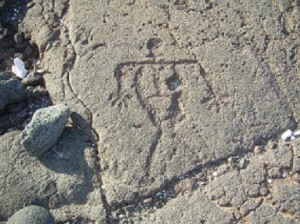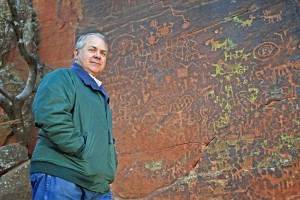
Camp Verde AZ Archaeology Center works to protect local ancient ruins artifacts
Sedona AZ (March 4, 2016) – Vandalism and looting are major threats to cultural resources on Federal and State lands. The Verde Valley has had several high-profile examples of graffiti, wanton damage and digging for artifacts at ancient ruins. These sites are important to today’s Native Americans and the cultural heritage of the Verde Valley. To help land managers address these problems, the Verde Valley Archaeology Center established the Verde Valley Site Watch Program. This program seeks to enhance the site steward program operated by Arizona State Parks within the Verde Valley.
In 2015, the Center received grants from the Arizona Community Foundation of Sedona and also of Yavapai County for the Site Watch Program. The Center has been working with the U.S. Forest Service and Arizona State Parks to assist in upgrading their training and recruitment materials as well as seeking innovative ways to protect these irreplaceable cultural resources.

Ken Zoll, Director of the Camp Verde Arizona Archaeology Center
The Center became aware of a grant awarded in 2015 by the National Park Service’s National Center for Preservation Technology and Technology. Twelve grants totaling $427,000 were awarded to provide funding for innovative research, training, and publications that develop new technologies or adapt existing technologies to preserve cultural resources.
One of these grants that caught the attention of the Center was to the Research Foundation of the State University of New York (RF-SUNY), Syracuse, New York, for a project entitled “Novel Electronic Technology for Real-time Detection of Trespass at Archaeological Sites.” RF-SUNY is a private, nonprofit corporation under contract to the State University of New York (SUNY) for the administration of sponsored research and programs conducted by faculty and staff at SUNY’s sixty-four campuses.
Dr. James Gibbs at the State University of New York, in collaboration with Irbis Solutions Inc., proposed to adapt patent-pending anti-poaching technology for wildlife to the particularities of protecting archaeological, architectural and historic sites. Novel electronic technology now exists that can inexpensively report in real-time on trespass at vulnerable sites in remote areas. The goal of the project is to enhance the existing technology to meet the particular needs of cultural resources protection. Anticipated needs include improvements to mobile device interfaces and wireless sensors and trail camera triggers to record intrusion events at vulnerable sites for cultural resources.
In a nutshell, the system employs a communications base station that works with a satellite network to send messages from anywhere outside of cell phone networks where most endangered archaeological / sacred sites are located. The base station is hooked to sensors, some of which are extremely reliable (metal detectors, break beams, mechanical switches and temperature sensors) and some of which are experimental (face detection). Everything is hooked together by cables and buried for the most part but a wireless is being developed to do away with the cables. Alerts (detections) are sent remotely and can be received via email, text messaging or other means (and mapped on a website). This generates information in real time on who is where and when, and can assist the land manager in intercepting people or simply monitoring traffic. The idea is to help increase the efficiency of existing protection efforts.
The project will do its first pilot installation in the Bandelier National Monument outside Santa Fe. The pilot system is highly flexible with the ability to support at least seven different sensor configurations. Metal detectors may be the most useful sensor for archaeological sites as they can detect people carrying shovels as well as ATVs and vehicles. The specific types of sensor configurations may vary in any given monitoring situation. The grant project directors will be visiting the Verde Valley Archaeology Center in March and will loan a unit to the Center to run tests at a local site. The Center is the manager of six archaeological properties in the Verde Valley that are owned by the Archaeological Conservancy. One of those sites will be selected for the test.
Ken Zoll, Executive Director of the Archaeology Center, said “We are very excited about the possibilities offered by this new technology. There are simply not enough human eyes monitoring these sites. In addition, some sites are very remote making regular visits difficult. This could be a godsend in those situations.”
The technology does have costs (especially the satellite interface) but it can be installed without any specific expertise. The Center is eager to determine if the technology will work to enhance its cultural protection efforts. This is a new foray for the equipment away from anti poaching of wildlife but it is very much in line with the overall goals to help protect endangered resources whatever forms they take.
For more information on the Center’s Verde Valley Site Watch Program, visit their website at www.vvarchcenter.org or call the Center at 928-567-0066.

Read www.SedonaEye.com for daily news and interactive views!

